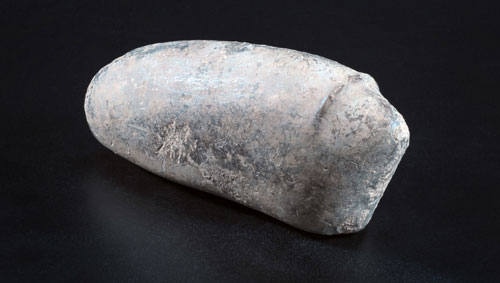(Communicated by the Israel Antiquities Authority)
Two figurines from the New Stone Age (Pre-Pottery Neolithic B) were
discovered in excavations the Israel
Antiquities Authority is currently conducting at the Tel Motza
archaeological site, prior to work being carried out on the new Highway 1 from
Sha'ar HaGai to Jerusalem by the National Roads Company.
According to Anna Eirikh and Dr. Hamoudi Khalaily, directors of the
excavation at the site on behalf of the Israel Antiquities Authority, "The
figurines, which are 9,000-9,500 years old, were found near a large round
building whose foundations were built of fieldstones and upper parts of the
walls were apparently made of mud brick. The first figurine, in the shape of a
ram with twisted horns, was fashioned from limestone and is c. 15 cm in size.
The sculpting is extraordinary and precisely depicts details of the animal’s
image; the head and the horns protrude in front of the body and their
proportions are extremely accurate. The body was made smooth and the legs of the
figurine were incised in order to distinguish them from the rest of the body.
The second figurine, which was fashioned on hard smoothed dolomite, is an
abstract design; yet it too seems to depict a large animal with prominent horns
that separate the elongated body from the head. The horns emerge from the middle
of the head sideward and resemble those of a wild bovine or buffalo."

Photo: Yael Yolovitch, courtesy of the Israel Antiquities
Authority
According to Dr. Khalaily, "The Pre-Pottery Neolithic B period (the eighth
millennium BCE) is considered one of the most fascinating chapters in the
history of mankind; many changes took place in it that shaped human society for
thousands of years to come. During this period, the transition began from
nomadism, based on hunting and gathering, to sedentary life, based on farming
and grazing. It was at this time that mankind began to inhabit permanent
settlements and started building settlements that extended across a large area.
In several sites that were exposed in our region remains were discovered
indicating preliminary architectural planning of those same settlements and
complex engineering capabilities including the construction of two story houses.
The process of animal and plant domestication was accelerated in this period.
The archaeological evidence from Pre-Pottery Neolithic B, particularly the
artistic objects such as the figurines that were discovered at Tel Motza,
teaches us about the religious life, the worship and the beliefs of Neolithic
society. Other evidence on the subject has also been derived from the study of
tombs and funerary customs of the same prehistoric society."
Dr. Khalaily adds, "It is known that hunting was the major activity in this
period. Presumably, the figurines served as good-luck statues for ensuring the
success of the hunt and might have been the focus of a traditional ceremony the
hunters performed before going out into the field to pursue their prey/"
Another theory presented by archaeologist Anna Eirikh, his research partner,
links the figurines from Motza to the process of animal domestication - such as
the wild bovine and different species of wild goat.
The figurines that were discovered in the current excavations at Tel Motza
join other unique finds that were previously exposed at this site. We can
conclude from these artifacts that the site at Tel Motza was most likely the
largest of its kind in the mountainous region around Jerusalem.